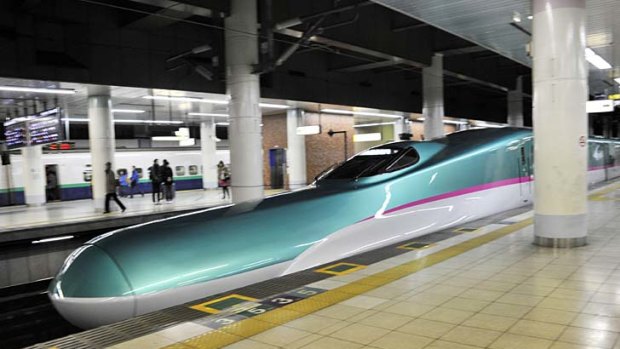
Japan's most recent bullet train, the 'Hayabusa' or Falcon travels at 300 kilometre per hour and boasts a luxury carriage modelled on airline business class.Credit: AFP
The train lovers in Canberra – this year, it’s the Greens and Labor – are trying to sell us the shiny, new, fast 2011 model and, I have to say, I’m smitten by it.
I’m totally sold on the idea of jumping into a train at Central or Southern Cross, with spacious seating and a big tray table, settling back to read the news on my laptop and arriving three hours later in Melbourne or Sydney after quick spin through Henry Lawson country.
But then, I’m an easy sell if it involves another way of long-distance travel beside using the airline system, with seating space smaller than it’s ever been, and the Australian airports system, whose monopoly private owners are “thrashing the assets” to within an inch of their lives.
And I’m not alone. The idea of fast rail is incredibly popular in Australia, which has a 150-year record of either stuffing up major infrastructure (let’s start with state rail gauges; lately it’s private toll roads) or squibbing it (water supply, the previously mentioned private airports free-for-all).
Run an opinion poll today and a clear majority will want the east coast fast train, which was the subject of an initial consultant’s feasibility report commissioned by the federal government. It’s long overdue, many believe, and has many spin-off benefits.
It’s just a pity if you live in North Queensland, the NT, WA, SA or Tassie, because you’ll get nothing (although Tassie gets a generous helping of Bass Strait ferry subsidies).
But if you take a closer look at the report, what we’re being offered is a very expensive system paid for 100 per cent by taxpayers. “International experience suggests it is unrealistic to expect the capital cost of a HSR network to be recovered,” the report notes dismissively.
The bill? From $60 to $100 billion or, in ballpark terms, up to $10,000 per Australian household.
This reflects the fact that Australia has become a very expensive place to build anything, but also – pardon the language – the pig’s trough syndrome, where anything built by government is expected to cost multiples of the bill if it was a private investment.
You’ll hardly hear a whisper of criticism of the idea from business, as many of their rank will be lining up for a slice of the spoils.
Yet, 20 years ago, when industry was driving the fast rail program, the projected cost was a fraction.
In 1991, a consortium comprising BHP and others was proposing to build a Melbourne-Sydney fast train for $5.3 billion. In 20 years, prices have roughly doubled, so we might expect the same project if it was resurrected to cost $10-$15 billion. Instead, we’re being quoted $30-$50 billion for the half of the project that will be the Melbourne-Sydney segment.
There’s no doubt in my mind that the consultants have got the projected patronage figures right. “It is predicted that approximately eight million passengers could travel on a HSR (high-speed rail) network between Sydney and Melbourne in 2036, and 3.5 million passengers between Brisbane and Sydney in 2036,” the report says. “This equates to approximately half of the projected air market for both sectors in 2036.”
Those are very modest assumptions. On my analysis of air travel in 2010, there were around 25 million one-way air passenger trips between Melbourne, Albury, Canberra, Sydney, Newcastle, Port Macquarie, Coffs Harbour, Ballina, Gold Coast, Brisbane and Maroochydore travelling all or part of the way. Add about a million people a year already travelling between Melbourne, Sydney and Brisbane by train, then add about half that travelling by bus. Then consider there are already 100 million passenger trips taken each year on the east coast, most of them taken by car, according to the report.
But it’s not just about tourism. Hundreds of thousands of people realistically would be able to move to the Hunter Valley or the Southern Highlands or even Canberra and commute to Sydney for work. Ditto for people living in Wangaratta and points south – even those in Albury-Wodonga – being able to commute to Melbourne; and Lismore, Byron Bay and Murwillumbah becoming dormitories for Brisbane workers.
This is old-fashioned decentralisation with vast social benefits – and benefits for the nation. Many of the nightmares of suburban sprawl in Sydney and Melbourne could be exported to areas further into the country. Of course, that creates new problems (“challenges” in modern political-speak), but looks to me like a net benefit, compared with the present.
But, if we’re going to do it, it can’t be a free-money festival, especially since it’s ours. It has to be competitively priced or we’ll saddle our children and theirs with a costly hangover.
Can a fast train system be done competitively? Do the social “multipliers” justify the cost? Or is it just a great big white elephant?
Sign up for the Traveller Deals newsletter
Get exclusive travel deals delivered straight to your inbox. Sign up now.